
Forsythia, is a genus of flowering plants in the olive family Oleaceae. There are about 11 species, mostly native to eastern Asia, but one native to southeastern Europe. Forsythia – also one of the plant's common names – is named after William Forsyth.

Deutzia is a genus of about 60 species of flowering plants in the family Hydrangeaceae, native to eastern and central Asia, and Central America and also Europe. By far the highest species diversity is in China, where 50 species occur.
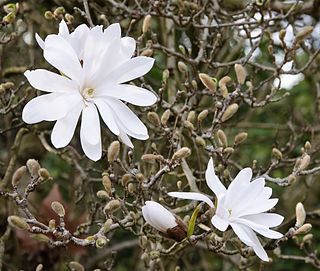
Magnolia stellata, the star magnolia, is a slow-growing deciduous shrub or small tree native to Japan. It bears large, showy white or pink flowers in early spring, before its leaves open. This species is closely related to the Kobushi magnolia, and is treated by many botanists as a variety or even a cultivar of that. However, Magnolia stellata was accepted as a distinct species in the 1998 monograph by Hunt.
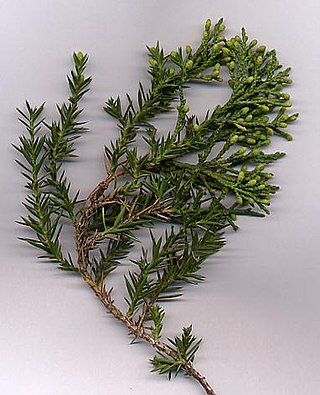
Juniperus chinensis, the Chinese juniper is a species of plant in the cypress family Cupressaceae, native to China, Myanmar, Japan, Korea and the Russian Far East. Growing 1–20 metres tall, it is a very variable coniferous evergreen tree or shrub.

Hydrangea macrophylla is a species of flowering plant in the family Hydrangeaceae, native to Japan. It is a deciduous shrub growing to 2 m (7 ft) tall by 2.5 m (8 ft) broad with large heads of pink or blue flowers in summer and autumn. Common names include bigleaf hydrangea, French hydrangea, lacecap hydrangea, mophead hydrangea, and hortensia. It is widely cultivated in many parts of the world in many climates. It is not to be confused with H. aspera 'Macrophylla'.

Yucca filamentosa, Adam's needle and thread, is a species of flowering plant in the family Asparagaceae native to the southeastern United States. Growing to 3 metres tall, it is an evergreen shrub valued in horticulture.

Salvia greggii, the autumn sage, is a herbaceous perennial plant native to a long, narrow area from southwest Texas, through the Chihuahuan Desert and into the Mexican state of San Luis Potosi, typically growing in rocky soils at elevations from 5,000 to 9,000 ft. It was named and described in 1870 by botanist Asa Gray after Josiah Gregg, a merchant, explorer, naturalist, and author from the American Southwest and Northern Mexico, who found and collected the plant in Texas. It is closely related to, and frequently hybridizes with, Salvia microphylla. Despite the common name "autumn sage", it blooms throughout the summer and autumn.
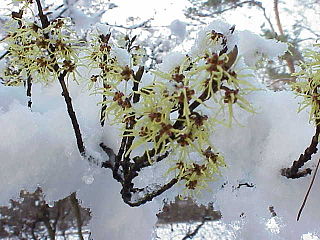
Hamamelis mollis, also known as Chinese witch hazel, is a species of flowering plant in the witch hazel family Hamamelidaceae, native to central and eastern China, in Anhui, Guangxi, Hubei, Hunan, Jiangxi, Sichuan, and Zhejiang.
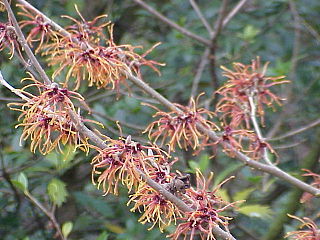
Hamamelis×intermedia, the hybrid witch hazel, is a flowering plant in the family Hamamelidaceae. It is a hybrid of garden origin between H. japonica and H. mollis. Its Latin name refers to its intermediate appearance between those two species.
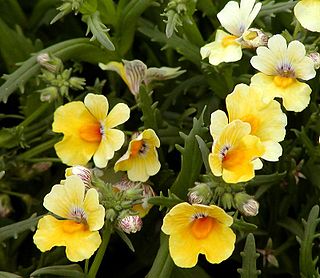
Nemesia is a genus of annuals, perennials and sub-shrubs which are native to sandy coasts or disturbed ground in South Africa. Numerous hybrids have been selected, and the annual cultivars are popular with gardeners as bedding plants. In temperate regions they are usually treated as half-hardy, grown from seed in heat, and planted out after all danger of frost has passed.
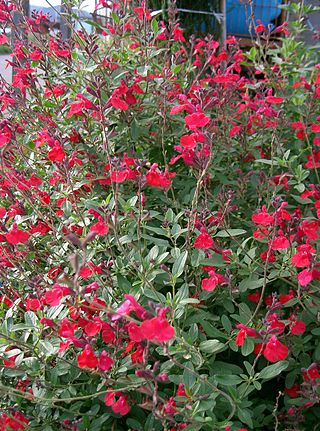
Salvia microphylla, the baby sage, Graham's sage, or blackcurrant sage, is an evergreen shrub found in the wild in southeastern Arizona and the mountains of eastern, western, and southern Mexico. It is a very complex species which easily hybridizes, resulting in numerous hybrids and cultivars brought into horticulture since the 1990s. The specific epithet microphylla, from the Greek, means "small leaved". In Mexico it is called mirto de montes, or "myrtle of the mountains".

Cercidiphyllum japonicum, known as the Katsura, is a species of flowering tree in the family Cercidiphyllaceae native to China and Japan. It is sometimes called caramel tree for the light caramel smell it emits during leaf fall.

Hydrangea paniculata, or panicled hydrangea, is a species of flowering plant in the family Hydrangeaceae native to southern and eastern China, Korea, Japan and Russia (Sakhalin). It was first formally described by Philipp Franz von Siebold in 1829.

Ceratostigma willmottianum, Chinese plumbago, is a species of flowering plant in the family Plumbaginaceae that is native to western China and Tibet. It is an ornamental deciduous shrub that grows to 1 metre in height, with pale blue plumbago-like flowers appearing in autumn as the leaves start to turn red.
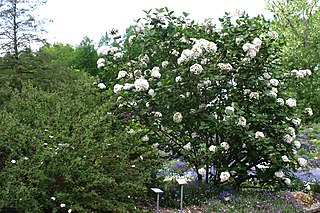
Viburnum carlesii, the arrowwood or Korean spice viburnum, is a species of flowering plant in the family Adoxaceae, native to Korea and Japan and naturalised in Ohio, USA. Growing to 2 m (7 ft) tall and broad, it is a bushy deciduous shrub with oval leaves which are copper-coloured when young. Round clusters of red buds open to strongly scented, pale pink flowers in late spring. These are followed in late summer by oval red fruits ripening to black in autumn.
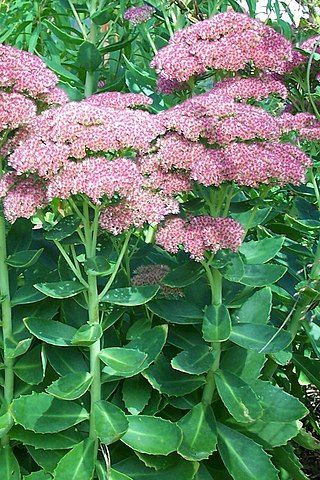
Hylotelephium, syn. Sedum, is a genus of flowering plants in the family Crassulaceae. Various species have been hybridized by horticulturalists to create new cultivars. Many of the newer ones are patented.

Viburnum × bodnantense, the Bodnant viburnum, is a Group of hybrid flowering plant cultivars of garden origin. They originate in a cross between V. farreri and V. grandiflorum made by Charles Puddle, head gardener to Lord Aberconway at Bodnant Garden, Wales around 1935.

Elaeagnus × submacrophylla, formerly known as Elaeagnus × ebbingei, is a hybrid between Elaeagnus macrophylla and Elaeagnus pungens. Several cultivars, including 'Gilt Edge', are grown in gardens as ornamental plants. Both the hybrid and 'Gilt Edge' have gained the Royal Horticultural Society's Award of Garden Merit.

Stachyurus chinensis (中国旌节花), Chinese stachyurus, is a species of flowering plant in the family Stachyuraceae, native to China and Taiwan. It is a spreading deciduous shrub growing to 2.5 m (8 ft) tall by 4 m (13 ft) wide. Stiff, pendent racemes of bell-shaped, greenish-yellow flowers are borne on glossy, dark brown branches in winter and spring. It flowers two weeks later than the related S. praecox. The flowers are followed by simple ovate leaves which colour to pink and red before falling in autumn.

Forsythia europaea, commonly known as Albanian forsythia or European forsythia, is a species of flowering plant in the olive family, with a native range from Montenegro to northern Albania. It is the only species of Forsythia native to Europe; prior to its discovery in Albania in 1897, it was thought that all Forsythia were native to East Asia.






















